
- Bihar has the second-highest economic growth among poor states
- It has India's third-highest level of poverty
- Unemployment in Bihar is the highest among the poorest states
- 98% families in rural Bihar do not have access to toilets in their homes, the highest rate among poor states
The eastern state of Bihar India's 3rd-most populous with a population equal to Philippines is the focus of attention as its assembly is up for re-election soon. A bruising political battle is ahead, the biggest political test for Prime Minister Narendra Modi since he swept to power in 2014.
Opposing the juggernaut of Modi and Bharatiya Janata Party (BJP) president Amit Shah is the middle-of-the-centre combination of Rashtriya Janata Dal (RJD) chief Lalu Prasad and Janata Dal (United) chief Nitish Kumar.
While Chief Minister Kumar is credited with turning around the economy of Bihar, the state is still at the bottom rungs of India's poverty ladder, unemployment and public and personal infrastructure from highways to toilets at home.
Bihar grew faster than most other poor states
Eight socio-economically backward states of Bihar, Chhattisgarh, Jharkhand, Madhya Pradesh, Orissa, Rajasthan, Uttaranchal and Uttar Pradesh are referred to as the Empowered Action Group (EAG) states.
The central government constituted the EAG under the Ministry of Health and Family Welfare following the 2001 Census to stabilise the population in eight poor states struggling to contain a population explosion.
We will compare the performance of Bihar to other members of the EAG group and assess how the state has performed over the past 10 years.

Bihar's gross state domestic product (GSDP) growth is the second highest among EAG states at 9.9%, second only to MP, which clocked a growth rate of 11%.
"There is a difference between base levels and increments but as increments go, there is no question that some historically backward states in particular Rajasthan, Bihar, Madhya Pradesh and Chhattisgarh are growing fast," according to Bibek Debroy, economist and NITI Aayog member, speaking to The Hindu.
In 2005-06, Bihar's economy had declined 1.5%, then recorded a growth rate of 16.1% in 2006-07.
If we look at the break-up of Gross State Domestic Product (GSDP), services form a major part for all the eight states, with the exception of Jharkhand.
Bihar's services sector delivers almost 62% of the total GSDP for the year 2013-14. This is followed by agriculture with 16%.
Bihar has the highest unemployment among India's poorest states
Bihar has the highest rural and urban unemployment among EAG states.

There has been an improvement in the unemployment numbers for Bihar in urban areas. While it was 7.3% in 2009-10, it has declined to 5.6% in 2011-12.
The opposite is true in rural areas: the unemployment rate has gone up from 2% to 3.2%.
Bihar has third-highest poverty level in India
Bihar has the third-highest percentage of people living below the poverty line defined as the ability to live on Rs 26 per person per day in rural areas; Rs 31 per person per day in urban areas at 33.7%, behind Chhattisgarh with 39.9% and Jharkhand with 36.9%

As many as 32 million people below the poverty line in Bihar live in rural areas.
If we look at data from the 2004-05 poverty estimates, Bihar was the poorest state, with 54% of its total population below the poverty line.
Bihar has received accolades for poverty reduction. However, compared to other EAG states, Bihar still has the second-highest number of people below the poverty line, 35.8 million, after Uttar Pradesh at 58.9 million.
When we compared the number of people pulled out of poverty since 2004-05, estimates show that Rajasthan and Odisha have performed better by pulling out almost 51% and 37% people, respectively, out of poverty.
Bihar has managed to pull out only 26% of its people out of poverty.
In personal and public infrastructure, Bihar struggles to catch up
While the economy is doing well, Bihar still lags behind in the development of infrastructure.
We have compared two key aspects to highlight the backwardness:
- State highways; and
- Toilet facilities in households as part of social infrastructure.
Roads: Maharashtra accounted for the largest share (22.9 %) of state highways as on March 31, 2013, according to data released by the Ministry of Road Transport.
Karnataka (12.3%), Gujarat (10.9%), Madhya Pradesh (6.5%) and Tamil Nadu (6.4 %) are the other top states. These five states accounted for about 59% of the total length (150,000 km) of state highways.
EAG states account for 36% of state highways, although they are home to 46% of India's population. Bihar has no more than 4.9% of India's state highways, although it is home to 8.6% of India's population.
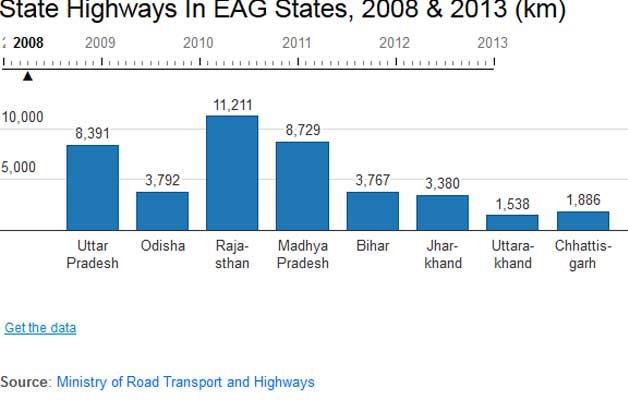
Bihar did well in surfacing highways surfaced roads, the term used in the ministry reports, refers to metalled roads or roads with bituminous or cement concrete tops until 2008. That pace slackened over the next five years to 2013: 193,000 kilometres of state highways were built but no more than 61% were surfaced.
Toilets: As many as 98% of families in rural Bihar do not have access to toilets at home, the highest rate among EAG states.
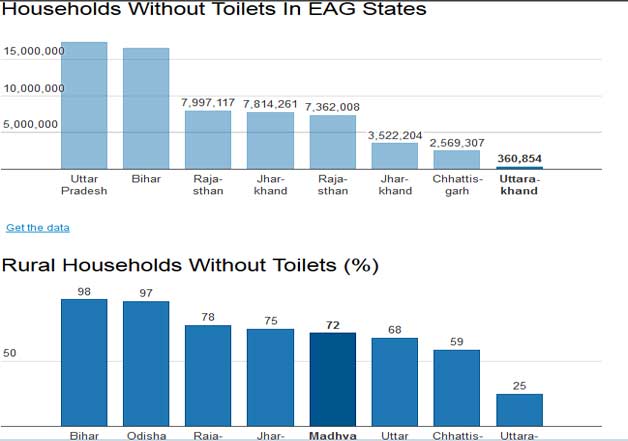
There are 16.8 million rural households in Bihar, according to 2011 census data. Of these, 16.4 million are without toilets, according to target achievement data under Swachh Bharat Abhiyan.
(The second part of this three-part series will focus on social indicators such as education, health and crime)
- Bihar has the lowest enrolment in secondary schools among poor states
- Bihar's crime rate is second highest among poor states
- Bihar has cut its infant mortality rate and now does better than some richer states
- Bihar's maternal mortality is the lowest among poor states
Bihar India's third-most populous state with as many people as the Philippines is the focus of attention, as IndiaSpend reported in the first part of this series as its legislative assembly prepares for re-election soon.
We have seen how Bihar lags in terms of economic and infrastructure development.
Here we look at data on socio-economic indicators of the state and compare it with the Empowered Action Group (EAG) states, eight poor, backward provinces Bihar, Chhattisgarh, Jharkhand, Madhya Pradesh, Orissa, Rajasthan, Uttaranchal and Uttar Pradesh.
Bihar has India's lowest literacy rate
Bihar has India's lowest literacy rate, according to the 2011 census: 64% of Bihar's 104 million people are literate, a rate lower than several, poor African countries, including Malawi, the two Congos and Sudan.
The Indian literacy rate is 74%.
Bihar's gross enrolment ratio at the primary level (age 6-14; grade 1 to 8) is lower than 100, although education is now compulsory for all children aged six to 14.
(Gross Enrolment Ratio or GER is the enrolment in a specific level of education, regardless of age, expressed as a percentage of the eligible official school-age population, corresponding to the same level of education in a given school-year. If there is late or early enrolment, or repetition of a grade, total enrolment can exceed the population of the age group that officially corresponds to the level of education, leading to ratios greater than 100.)
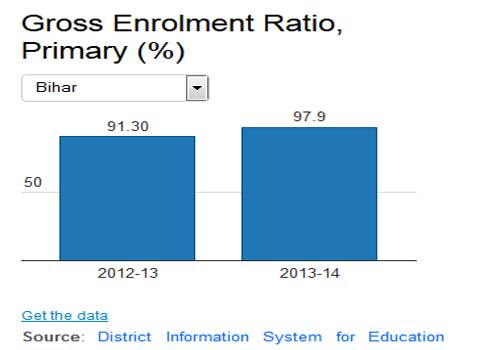
GER for secondary level schooling (age 15-16; grade nine and 10) in Bihar was 60 in 2013-14. This means that beyond the compulsory age of education (six-14 years), not many children are going to schools in Bihar.
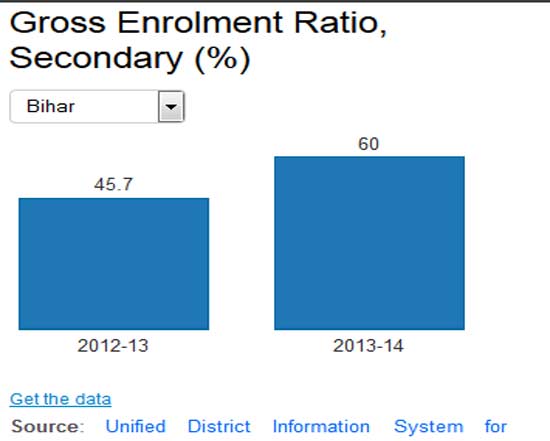
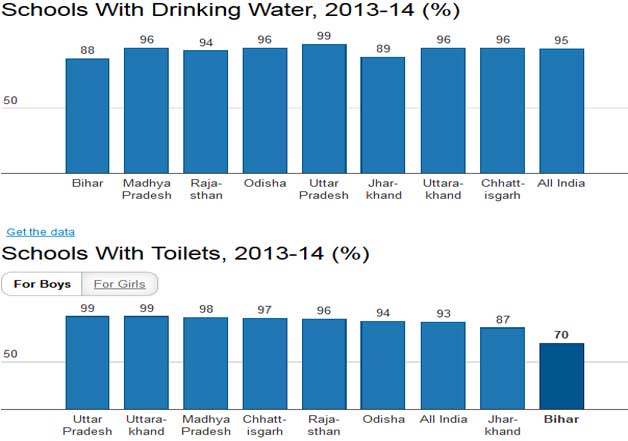
Only 58% schools in Bihar had separate toilets for girls in 2013-14. Drinking water was available only in 88% schools, the lowest among EAG states. Poor infrastructure is reportedly a major reason for low enrolment in schools, especially toilets.
Bihar reported only 31.7% project completion of the Swachh Vidyalaya (Clean Schools) programme till March 31, 2015.
Bihar's infant mortality better than MP, UP, Odisha, Rajasthan, Chattisgarh
Madhya Pradesh had the worst infant mortality rate (IMR) in the country with 54 deaths per 1,000 live child births in 2013.
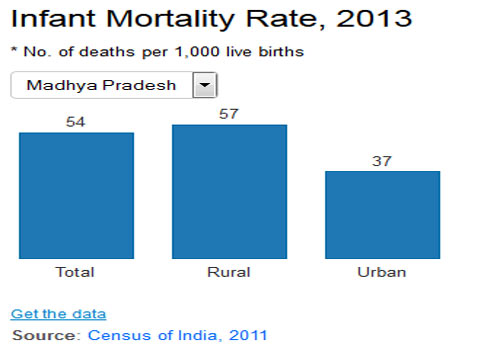
With an IMR of 42, Bihar is doing well, compared to other EAG states. The state has improved its IMR from 48 in 2010 to 42 in 2013, better now than Bangladesh, Namibia, Myanmar and Pakistan.
Despite its improvements, Bihar is still a distance from the worst-performing southern state Karnataka (31), Maharashtra (24), Gujarat (36) and a long way from Kerala (12)
Rural IMR continues to be a matter of concern at 42, while the urban number is 33.
The reduction in IMR has been more significant in rural areas, declining from 49 in 2010 to 42 in 2013. In urban areas, the IMR has come down from 38 to 33 over the same period.
A key reason for a lower death rate could be the improved use of oral-rehydration solution (ORS) among children suffering from diarrhea. Other improvements include better vaccination against diphtheria, pertussis, tetanus and measles.
Bihar has lowest maternal mortality among poor states
Bihar has the lowest maternal mortality ratio (MMR) among EAG states with 219 maternal deaths per 100,000 live births in 2013.
The state brought down MMR from 261 in 2007-2009, at a faster rate than Odisha.
However, the state's MMR is high compared to the national average of 178.
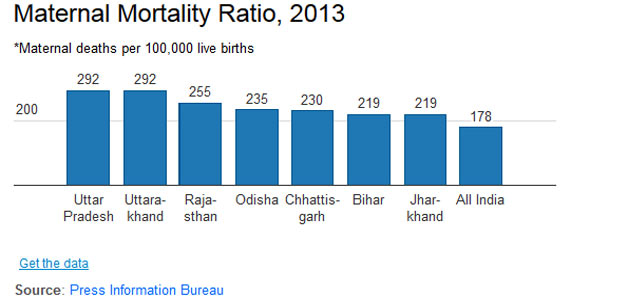
Strengthening of institutional factors has led to the reduction in deaths of females during childbirth. Deliveries at home have come down from 47% in 2012 to 42% in 2011. While safe deliveries went up from 59.9% to 64.5%, institutional deliveries went up from 51% to 55.7%.
Law and Order Still A Concern In Bihar
Bihar has the second-highest crime rate among EAG states with 30. With 8.6% of India's population, it accounted for 10% of violent crimes reported nationwide.
(Crime rate, defined as the number of offences per 100,000 population, is derived by first dividing the number of incidents in an area by the number of people living there, and then multiplying the resulting figure by 100,000, according to the National Crimes Record Bureau.)
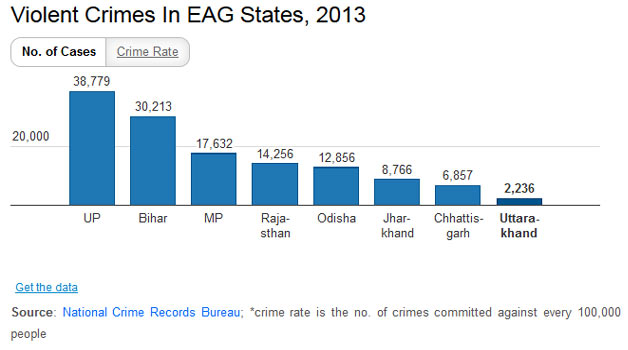
The crime rate in Bihar has gone up to 30.5 in 2013 from 25.1 in 2012. This could mean that more people are reporting crimes.
Almost 17% of crimes reported were against scheduled castes and scheduled tribes.
Bihar reported 3,441 murder cases, 10% of India's total murder cases in 2013.

Patna district reported the highest number of murder cases (286 cases) in Bihar.
Motihari district reported the highest number of attempt-to-commit-murder cases (719) in 2013.
Bihar has the second-lowest crime rate against children among poor states at 3.57 per 100,000 children. This is far lower than the national average of 13.23. The crime rate against children in poor states is the highest in Chhattisgarh at 37.68.
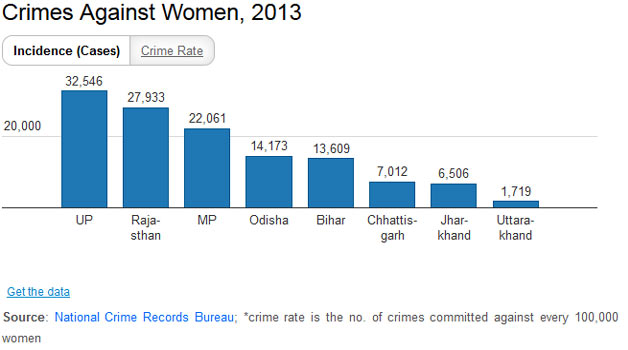
Bihar has the lowest crime rate against women: 28 per 100,000 women.The high population of Bihar (104 million, of which 49.8 million are women) could be one of the main reasons that crime rate is low compared to other poor states and the all-India level of 52.2.
With more than 13,600 cases, Bihar reported the fifth highest number of crimes against women among EAG states.
Bihar has the lowest crime rate against women: 28 per 100,000 women.The high population of Bihar (104 million, of which 49.8 million are women) could be one of the main reasons that crime rate is low compared to other poor states and the all-India level of 52.2.
With more than 13,600 cases, Bihar reported the fifth highest number of crimes against women among EAG states.
A caveat: NCRB data may not represent realities. IndiaSpend previously reported how crime and other data is fudged in neighbouring Uttar Pradesh.
Bihar has the second-highest number of crimes reported (17%) against scheduled castes in India.
The rate of scheduled-caste girls enrolled in primary schools is less than half the rate of all girls.
Bihar has the second-lowest percentage of “active” scheduled-caste workers under the national rural jobs programme.
The first part of this series explored Bihar's economic growth and personal and public infrastructure and the second part, education, health and crime. The third and final part looks at the role of scheduled castes.
Caste has always played an important role in the politics of Bihar, which is set to re-elect its assembly soon. Nitish Kumar, the chief minister (CM) of Bihar whose politics has strongly subsumed caste, is himself from an other backward caste (OBC). Former CM Jitan Ram Manjhi is a musahar (rat catcher), a scheduled caste.
The government of Bihar has allocated Rs 10,006 crore ($1.5 billion) for scheduled castes for 2015-16. This money will be used for overall welfare of the scheduled caste population in the state.
Of 104 million Biharis, 17.9 million are scheduled castes or scheduled tribes, and in a state that sits on India's bottom rung of development, SCs and STs—despite recent years of empowerment—occupy the lowest economic rung in Bihar.
With 16.5 million or 15.9% of the total population of the state SCs, Bihar has the fifth-highest population of SCs among eight Empowered Action Group (EAG) states, or poor states—Bihar, Chhattisgarh, Jharkhand, Madhya Pradesh, Orissa, Rajasthan, Uttaranchal and Uttar Pradesh.
Since the ST population in Bihar is low (1.2%), compared to other EAG states, such as Chhattisgarh (30%), Jharkhand (26%) and Odisha (22%), we will focus on issues faced by the SCs.
Rural employment for SC workers is good only on paper
A quarter of all workers registered under the National Rural Employment Guarantee Act (NREGA) —designed to provide 100 days of work for the poor in rural India—are SCs.
SC workers make up 25% of the labour force registered under NREGA, second highest after Uttar Pradesh (33%) among EAG states, NREGA data show.
What is not as encouraging is the proportion of “active” workers. Bihar is only better off than Jharkhand among poor states in the proportion of active workers to those registered.
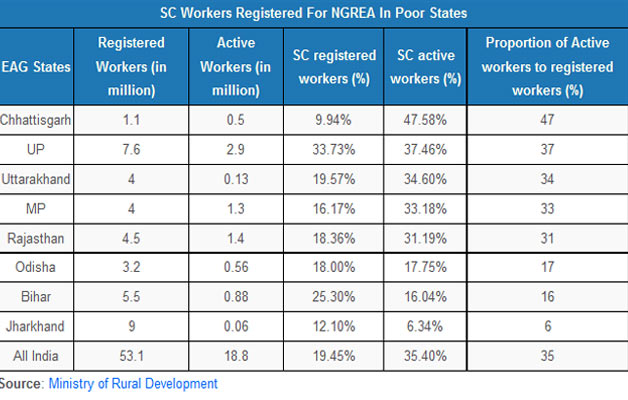
Jharkhand has the least proportion of active workers, followed by Bihar and Odisha. The highest number of active workers among the poor states are in Chhattisgarh (47%).
Uttar Pradesh with 27.8% and Uttarakhand with 24% are ranked first and second, respectively with regard to SC enrolment for primary education.
Crimes against SCs grow, more than a third of investigations pending
Bihar is now seeing more crimes against SCs compared to 2012, when it had the third-highest number of cases in the country.
Uttar Pradesh, with 20.5% of its population as SCs, accounted for 18% of all cases against SCs reported across the country, followed by Bihar with 17% (6,721) of all cases and Rajasthan (16.4%; 6,475 cases).
Bihar has 8% of India's scheduled-caste population, so the crimes against SCs are disproportionately high.
Enrolment of SC girls in primary schools languishes
SC children in Bihar make up 19.9% of primary school enrolment, giving the state fifth rank among EAG states. This is better than the rate of SCs in Bihar's population, but the rate of SC girls' enrolment is less than half that of all Bihari girls.
Bihar is ranked third among EAG states with regard to proportion of girls enrolled in primary schools after Chhattisgarh with 49.3% and Jharkhand with 48.9%. That is not saying a lot.
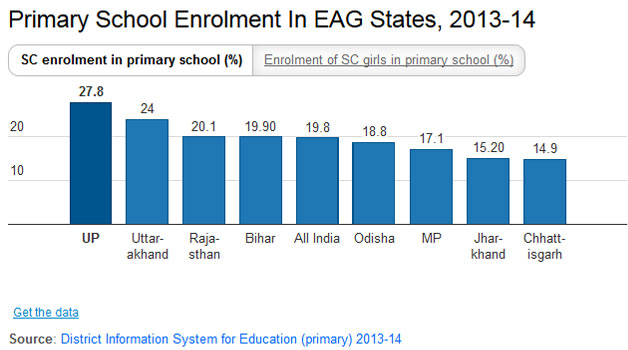
Uttar Pradesh with 27.8% and Uttarakhand with 24% are ranked first and second, respectively with regard to SC enrolment for primary education.
Crimes against SCs grow, more than a third of investigations pending
Bihar is now seeing more crimes against SCs compared to 2012, when it had the third-highest number of cases in the country.
Uttar Pradesh, with 20.5% of its population as SCs, accounted for 18% of all cases against SCs reported across the country, followed by Bihar with 17% (6,721) of all cases and Rajasthan (16.4%; 6,475 cases).
Bihar has 8% of India's scheduled-caste population, so the crimes against SCs are disproportionately high.
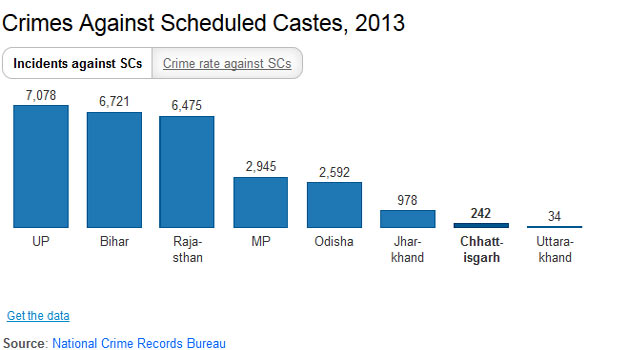
Nearly 35% of criminal cases against SCs registered are still pending with the police. Bihar accounted for nearly 23% of India's total pending cases of crimes against SCs in 2013.
Almost 90% of all the cases reported are pending in courts in Bihar, and the state has a conviction rate of only 13.1% for all the cases registered. This shows that, despite the high reporting of crimes against scheduled castes, few investigations are completed.
(Crime rate, defined as the number of offences per 100,000 people, is derived by first dividing an area's population by 100,000 and then dividing the number of offences by the resulting figure, according to the National Crime Records Bureau.)
(Indiaspend.org is a data-driven, public-interest journalism non-profit)






















